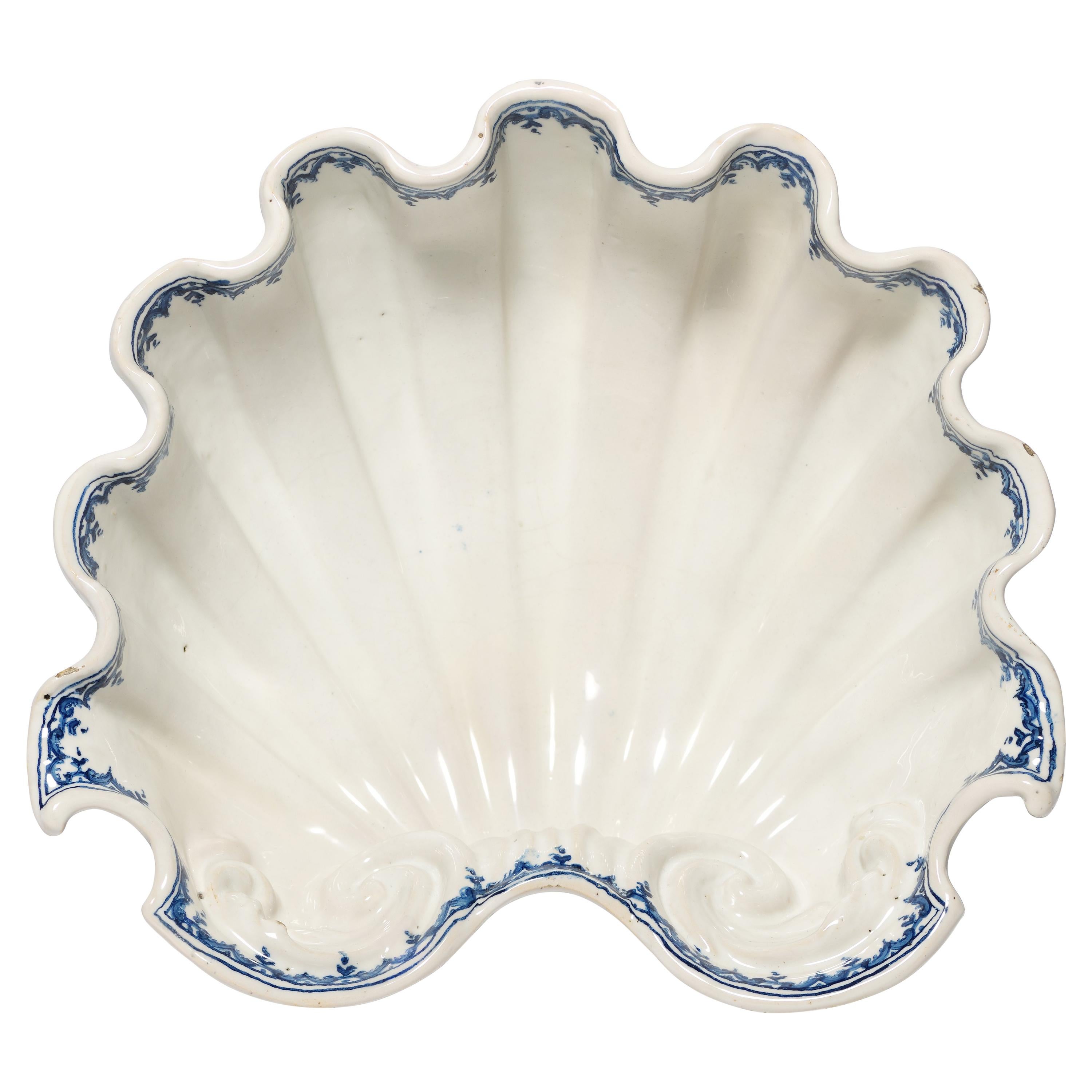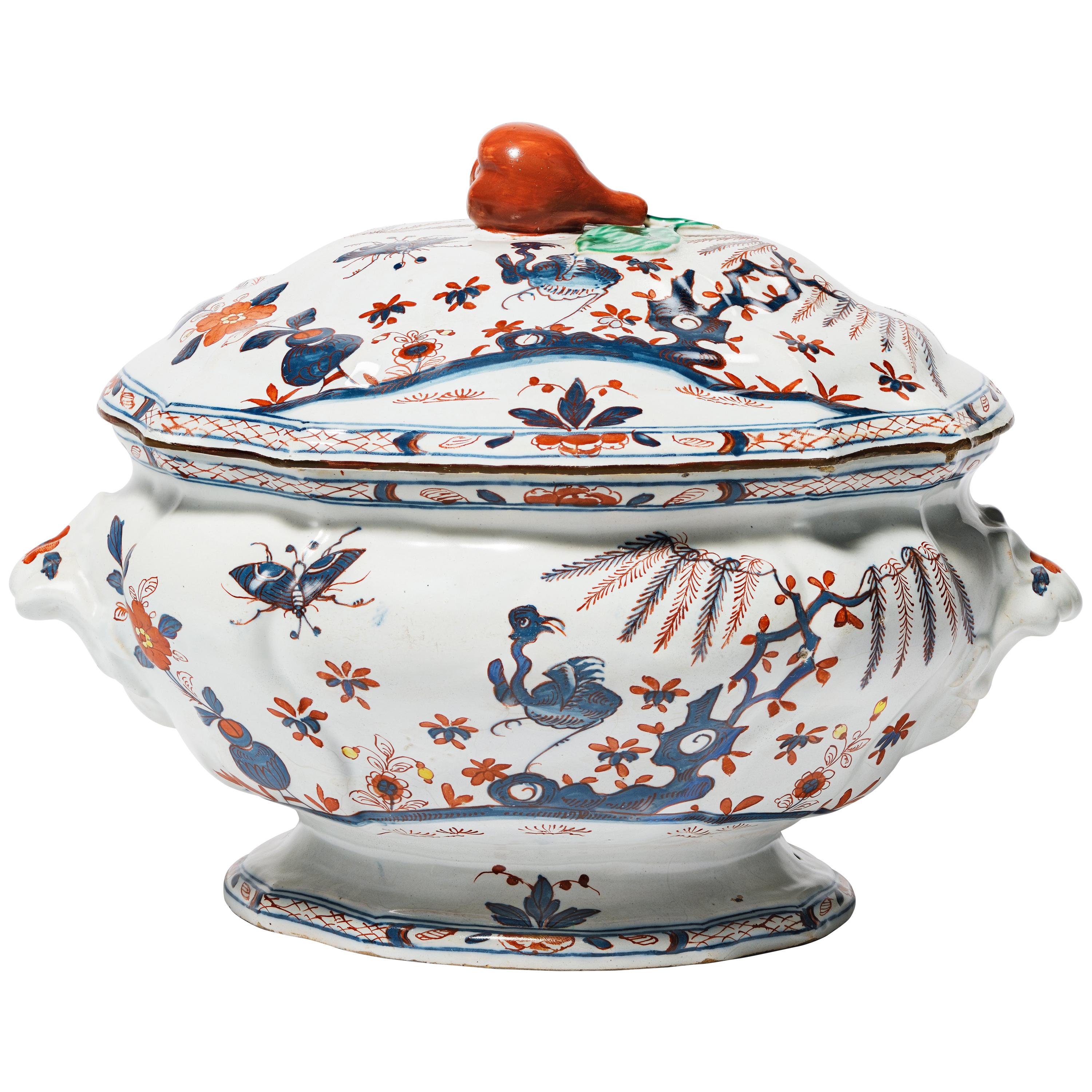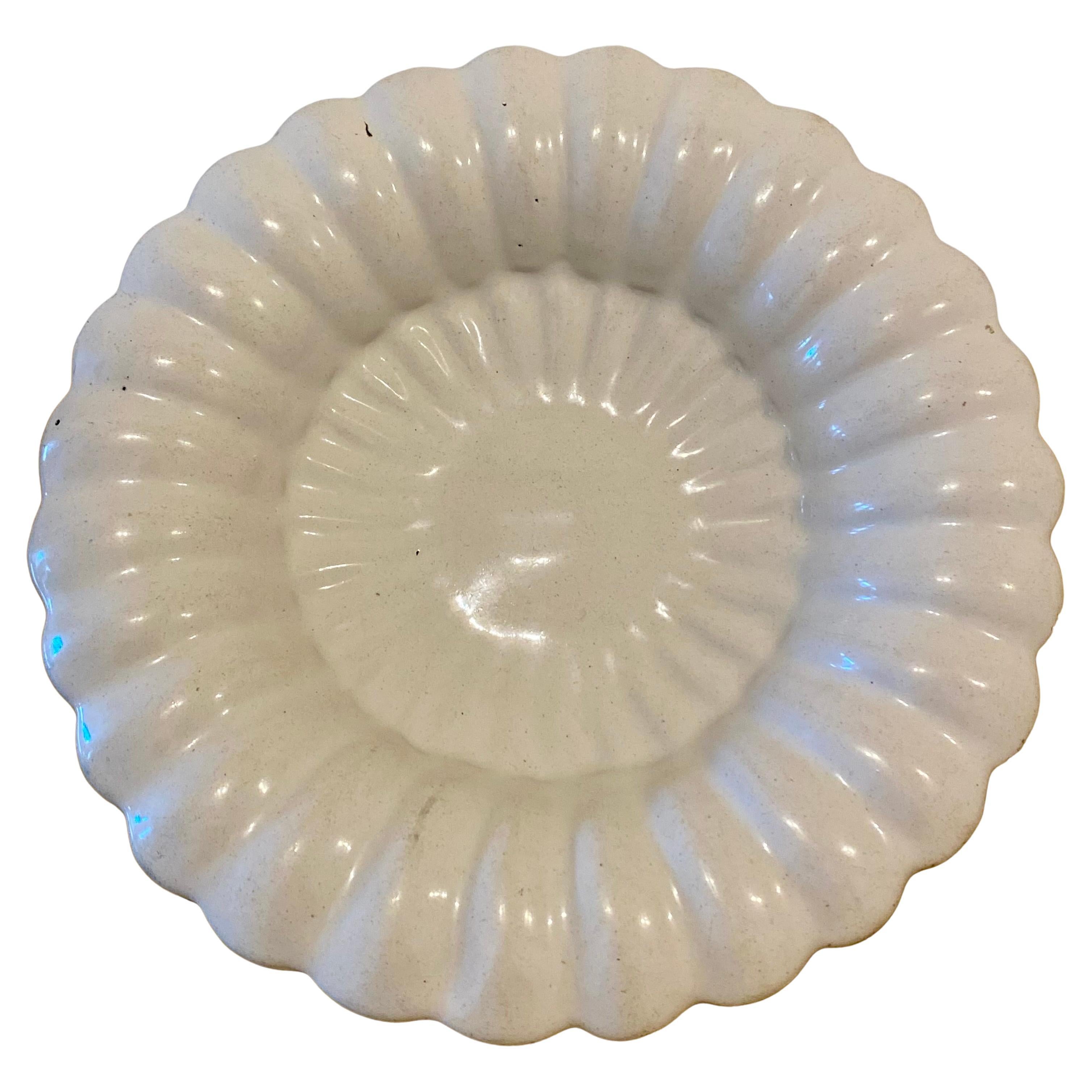Items Similar to Ancient Italian Renaissance Maiolica Crespina, Faenza, 1580 Circa
Video Loading
Want more images or videos?
Request additional images or videos from the seller
1 of 17
Ancient Italian Renaissance Maiolica Crespina, Faenza, 1580 Circa
About the Item
Crespina
Faenza, last quarter of the 16th century
Maiolica painted in two colors, light blue and yellow, on a thick, rich layer of white enamel.
It measures 2.24 in (5.7 cm) in height, 6.10 in (15.5 cm) in diameter.
lb 0.55 (kg 0.25)
State of conservation: mimetic restoration.
The small cup has a raised central “umbone”, a perforated brim and a shaped rim. It rests on a high jutting foot. The "crespina" shape, in some inventories is cited as "tacce de frute" (fruit cups). It was particularly appreciated in the Renaissance and has variants based on the formal types and the different sizes. The decoration, made according to the dictates of the “compendiario” style, used few standardized colors: blue and yellow on a thick white and shiny enamel, deliberately chosen as the colour which was most reminiscent of silver. This choice derived from a trend in creative design of the era: the shapes used in the molds were often taken from metal objects. An idea which would last throughout the Renaissance.
The work shows, in the middle of the “umbone”, a winged putto stepping forward while playing a long thin trumpet.
The depiction of the putto is fully representative of the repertoire of the Faenza workshops of the sixteenth century.
Some specimens with this type of decoration have been published in a volume by Carmen Ravanelli Guidotti: there appears the whole productive repertoire of this fundamental moment of transition between the taste for the “istoriato” style and the great simplification of decoration in the “compendiario” period. This style, in its simplicity, however, saw its expression in a rather varied collection of decorative subjects, including old-fashioned busts, cupids, warrior figures, as well as “istoriato” representations, albeit done in simpler colour tones.
Bibliography: Ravanelli Guidotti C., Faenza-Faïence ‘Bianchi’ di Faenza. Catalogo della mostra, Museo Internazionale delle Ceramiche, Faenza. Ferrara 1996, pp. 110 and 114.
- Dimensions:Height: 2.25 in (5.7 cm)Diameter: 6.11 in (15.5 cm)
- Style:Renaissance (Of the Period)
- Materials and Techniques:
- Place of Origin:
- Period:
- Date of Manufacture:circa 1580
- Condition:Repaired: Mimetic restoration. Minor structural damages. Minor fading. Mimetic restoration.
- Seller Location:Milano, IT
- Reference Number:1stDibs: LU4352214566251
About the Seller
4.3
Vetted Seller
These experienced sellers undergo a comprehensive evaluation by our team of in-house experts.
Established in 1860
1stDibs seller since 2018
19 sales on 1stDibs
Typical response time: 4 hours
Associations
International Confederation of Art and Antique Dealers' Associations
- ShippingRetrieving quote...Ships From: Milano, Italy
- Return PolicyA return for this item may be initiated within 14 days of delivery.
More From This SellerView All
- Ancient Italian Maiolica Faenza, Ferniani Factory, Circa 1700By Ferniani FactoryLocated in Milano, ITCenterpiece light blue maiolica shell Ferniani factory, early period: 1693-1776 Faenza, 1700 circa 5.5 in x 14.72 in x 13.77 in (14 cm x 37.4 cm X cm 35) lb 4.40 (kg 2) State of con...Category
Antique Early 1700s Italian Baroque Ceramics
MaterialsMaiolica
- Ancient Italian Maiolica Faenza, Ferniani Factory, Circa 1700By Ferniani FactoryLocated in Milano, ITCenterpiece white maiolica shell Ferniani factory, early period: 1693-1776 Faenza, circa 1700 Measures: 5.6 in x 14.72 in x 13.46 in (14.3 cm x 37.4...Category
Antique Early 1700s Italian Baroque Ceramics
MaterialsMaiolica
- Ancient Italian Maiolica Tureen Milano, 1770 circaBy Felice Clerici, Pasquale RubatiLocated in Milano, ITMaiolica tureen “allo struzzo” (ostrich decoration) Milan, Felice Clerici or Pasquale Rubati factory, circa 1750-1780 Measures: 9.25 in x 12.79 in x 10.23 in (cm 23.5 x cm 32.5 x cm 26) lb 4.78 (kg 2.17) State of conservation, a felûre consolidated inside with slight edge chipping restored. In Milan in the 18th century two Majolica warehouses were opened, the first, by Felice Clerici, in 1745, the second in 1756 by Pasquale Rubati. Traditionally this type of decoration has been attributed to the Pasquale Rubati factory. In reality the motif “allo struzzo”, one of the clearest examples of how the taste for chinoiserie met with considerable success during the 18th century, had been produced, in specimens of greater or lesser quality, by both Milanese manufactories. This Maiolica tureen has a swollen and ribbed oval bowl, rests on an extroflexed foot and shows stirrup handles. The tri-color ornament, in the typical tones of Japanese "Imari" decorations, shows an idealized oriental landscape that develops around a perforated rock and has a willow tree with long lance-shaped leaves framing the long-legged bird figure. The ornamentation is enhanced by decorative elements such as butterflies, small florets and a vase with a thin flowery stem. The lid is ribbed with a pear-shaped knob on top. The decoration was called in the Milanese manufactories "allo struzzo" (ostrich decoration) and this refers to the oriental figure Xian He or the crane, symbol of longevity, here losing its symbolic value. It is hypothesized that among some 16th century engravings...Category
Antique 1770s Italian Chinoiserie Ceramics
MaterialsMaiolica
- Ancient Pair of Italian Maiolica Dishes Milano, circa 1770By Felice ClericiLocated in Milano, ITTwo maiolica dishes, "Famille Rose" decoration Felice Clerici Factory Milan, 1770-1780 9.13 in (23.2 cm) each in diameter lb 1.32 (kg 0.6) State of conservation: perfect, except for...Category
Antique 1770s Italian Rococo Ceramics
MaterialsMaiolica
- Ancient Italian Maiolica Tureen, Rubati Manufacture, Milan, circa 1770-1780By Pasquale RubatiLocated in Milano, ITMaiolica tureen Pasquale Rubati Manufacture Milan, circa 1770 - 1780 Maiolica polychrome decorated “a piccolo fuoco” (third fire). It measures 6.69 in x 11,02 x 8.26 (17 x 28 x ...Category
Antique 1770s Italian Rococo Ceramics
MaterialsMaiolica
- Italian Maiolica Ancient Tureen, Lodi, 1770-1780By Antonio FerrettiLocated in Milano, ITMaiolica tureen Antonio Ferretti Manufacture Lodi, circa 1770-1780 Maiolica polychrome decorated “a piccolo fuoco” (third fire). It measures 9.05 x 12.59 x 9.05 in (23 x 32 x 23 cm) ...Category
Antique 1770s Italian Rococo Ceramics
MaterialsMaiolica
You May Also Like
- Italian Maiolica Crespina a Compendiario Style, Center Italy, Late 17th CenturyLocated in CHItalian Maiolica Crespina a Compendiario style, Central Italy, Late 17th century This Crispina has a convex shape on the front and a concave shape on the back, resting on a small ...Category
Antique Late 17th Century Italian Baroque Ceramics
MaterialsMaiolica
- Ceramic Hand Painted Strawberry Motif Serving Platter, ItalyLocated in Oklahoma City, OKA vintage hand-painted ceramic strawberry motif serving platter or relish dish. This serving dish features four wells that will accommodate dips, relishes ...Category
20th Century Italian Mid-Century Modern Ceramics
MaterialsCeramic, Paint
- 18th Century Ancient Faenza Pharmacy Jar Full PaintedLocated in PALERMO, ITPharmacy jug. Faenza, Italy. Majolica painted in blue monochrome, on a blue enameled background called berettino and tints of tin white.Category
Antique 18th Century Italian Ceramics
MaterialsMajolica
- Majolica Asparagus Saucer Luneville, circa 1880By LunevilleLocated in Austin, TXAqua Majolica asparagus saucer from Luneville, circa 1880.Category
Antique 1880s French Victorian Serving Pieces
MaterialsCeramic
- Green Majolica Fish Saucer Sarreguemines, circa 1930By SarregueminesLocated in Austin, TXGreen Majolica Fish Saucer Sarreguemines, circa 1930.Category
Vintage 1930s French Art Deco Serving Pieces
MaterialsCeramic
- Antique English Staffordshire Mason's Ironstone Toast Rack, circa 1920By Mason's IronstoneLocated in Pearland, TXA lovely antique English Staffordshire Mason's ironstone toast rack, circa 1920. Maker's mark on reverse. This fine toast rack has a beautiful floral design and would be wonderful fo...Category
Early 20th Century English Serving Pieces
MaterialsIronstone
Recently Viewed
View AllMore Ways To Browse
Thick Glass Italy
Small Cup
Antique Glass Restoration
Antique Trends
Antique Silver Paint Color
Antique Layer Glasses
Antique Layered Glass
Renaissance Style Silver
Old Italian Ceramics
Trumpet Glass
Trumpet Glasses
Glass Fruit Light
110 Silver
Blue And White Italian Ceramics
Faience Italy
Silver Cups Old
Blue Small Cups
Italian Renaissance Light





